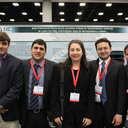Multiple Lacunar Infarcts in Paroxysmal Nocturnal Hemoglobinuria.
Kľúčové slová
Abstrakt
Paroxysmal nocturnal hemoglobinuria (PNH) is a rare acquired disease characterized by clonal hematopoietic stem cell disorder, with increased mortality and morbidity. Venous thrombosis is the most common cause of mortality in PNH. The relationship between PNH and cerebrovascular disease is unclear; few cases are reported in the literature, most of them related to cerebral venous thrombosis; In PNH the involvement of intracranial and extracranial arterial sites is very rare. We report a case of a 49-year-old woman who has a medical history of diabetes mellitus, hypertension, and PNH and presented multiple lacunar strokes in a routine consultation with a hematologist. A brain computed tomography (CT) scan showed lacunar infarcts, and magnetic resonance image showed acute ischemic stroke, multiple territory lacunar infarctions, and focal area of microbleeds in gradient echo sequence. A CT angiography showed V3 and V4 branches of the left vertebral artery occluded by a thrombus, and the posterior inferior cerebellar artery occluded, whereas the carotid system was normal. We discuss the presentation and physiopathology of stroke in PNH and other cases reported in the literature review.


